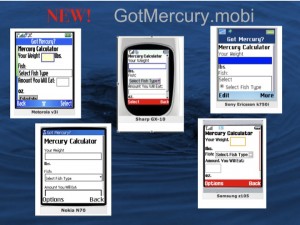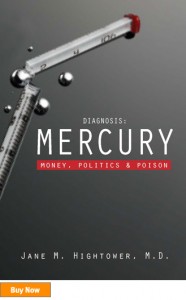Calling all kids, moms-to-be and women like me who eat fish a lot:
Since we’re evidently more at risk than others from harm due to mercury ingestion and fish consumption, there’s now a cool little cellphone calculator to check before you chomp.
GotMercury.mobi is an “on the go” extension of the GotMercury.org web site which I wrote about in this article where I interviewed Connie Evers, R.D., M.S., about children eating tuna, sushi, or ‘big fish’ from the sea that have ample time to become mercury-laden.
Just enter your weight, the seafood type, the amount of seafood you’ll be eating and it will calculate based on the updated EPA and FDA data. Cool, hmn? Brought to you by…Sea Turtle Restoration Project. You can download the free Got Mercury.org handy pocket card with website and turtle-safe seafood choices, as a nice ‘cheat sheet’ to help sort out the seafood myths and facts, from an eco-sustainable perspective AND a health-driven one…It’s hard to keep up with facts for fish eaters, especially since every time we turn around there’s a new ‘update’ questioning the stringency of FDA guidelines, and calling for revised standards of intake, especially for children…
Latest report is that even a few cans of tuna or fresh tuna per week is of concern. Hmn, snapshot of my fish-loving family this week alone? Clam chowder, calamari, a tuna Subway sandwich, wild salmon on the grill…eek! I’m toast. Too much mercury can lead to fatigue, headaches and memory loss with chronic exposure. (see, folks? It’s not midlife mania, it’s my dietary ways!
The Dept. of Health has come out with a ‘Healthy Fish Choice’ color-coded chart which is helpful, and for a more robust and highly up to date regional guide, I highly recommend the Monterey Bay Aquarium’s Seafood Watch online AND on mobile!
It’s not a ‘calculator’ like the Got Mercury.org app, but it’s comprehensive and details way beyond mercury hazards to encompass farming practices/harm to the environment, overfishing and what to buy/not to buy. Seafood Watch has always been my mainstay for info, and tomorrow they’re coming out with their all new pocket guide for SUSHI selections! (even hosting a Facebook party in digital youth-buzz style)
Also found a solid link-laden post a few weeks back addressing the wild vs. farmed salmon bit. Mark’s Daily Apple offered a ‘readers compilation’ of healthiest choices. On the ‘raised eyebrows’ front though, Sue Kwon reported on CBS5 some..um…fishy shenanigans that really stink.Not just with our own government disclosure on levels, but leading all the way back to…Iraq? (seriously, worth a read!)
“ConsumerWatch tested sushi and supermarket fish and found several samples of high-end fish like tuna, salmon, swordfish contained above average levels of mercury and in some cases more than 1 part per million. That is the legal level set by the FDA. But Bay Area physician Dr. Jane Hightower says it’s not set high enough. “It’s not protective, especially for people who enjoy to eat fish more than twice a week,” said Hightower, a general practioner who’s seen a number of mercury poisoning cases at San Francisco’s California Pacific Medical Center.”–CBS5
More than twice a week? Sheesh. My mercury/memory should be as scatter-brained as the Dory character in Finding Nemo…
After all, my waterski hub is The Fishmarket Restaurant, my tastes run to Asian comfort food (all those years in Hawaii) my neighbor from Japan makes sashimi and sushi platters regularly as a treat, and my doc has encouraged me to ‘go ahead and enjoy as much fish as I can’ to level out high cholesterol. (and yah, those fish oil tabs are NOT the same, bleh)
 Teri Shore, Program Director of Gotmercury.org, talked of the benefits of knowing what you’re consuming before you buy it,
Teri Shore, Program Director of Gotmercury.org, talked of the benefits of knowing what you’re consuming before you buy it,
“Sometimes it’s hard to remember which fish is low in mercury, but now seafood lovers can use their cell phones to check mercury levels before ordering seafood at their favorite restaurant or supermarket.”
I like this idea, especially since I’ve always guesstimated “if it’s big it’s lived long” as my yardstick of the high seas, and relied on my Seafood Watch guide.
I’m afraid I may be in for a rude awakening when I read Dr. Jane Hightower’s new book, published by acclaimed eco-resource, Island Press…
Dr. Hightower’s new book is called “Diagnosis Mercury” and the reviews alone give me pause…10-4 New Scientist review:
“…A voyage of discovery that led this idealistic physician into the murky waters of corporate cover-ups and conflicting science, bemused colleagues and corrupt officials, mass poisonings and what may be a widespread but obstinately unrecognized problem for ordinary consumers. She relates that voyage, and the surprising history of mercury, crisply and, for the most part, clearly in Diagnosis: Mercury…. I defy anyone not to be angry by the end of this book.” –New Scientist on Diagnosis Mercury
 Or from Paul Epstein, M.D., MPH, Center for Health and the Global Environment, Harvard Medical School:
Or from Paul Epstein, M.D., MPH, Center for Health and the Global Environment, Harvard Medical School:
“Dr Hightower’s intriguing tale takes us from her physician’s office to sites of mercury poisoning and through the halls of Congress where public policy will determine our future exposure to this heavy metal. Throughout, she shows how important it is to understand mercury’s wide-ranging health effects and the urgent need to set stricter limits on the amount of this known neurotoxin emitted from coal-fired power plants, which contaminates the fish we eat.” –
Sounds like Appetite for Profit in the seafood sector…
More on new health findings for kids soon, as I’m sure there will be a plethora of digital gizmos, apps and platforms launched at Health 2.0 tomorrow…
I’ll be blogging there the next two days about everything from childrens’ disease prevention, edu-sims, digital wellness resources, youth medical/STD confessional forums and online hubs for Q&A peer to peer, (Ypulse reports important research on teen online use, partnering with ISIS and Youth Noise and Peanut Labs—more on that soon). Health 2.0 will no doubt ALSO be discussing digital privacy/patient data-mining and info-security in the medical-digital frontier.
The panel I’ve most been waiting for? Gaming For Health on Thursday, (Oct 23rd@ 4:00) which includes Richard Buday from ArchImage; (designers of our Playnormous gaming friends e-healh site) Paul Puopolo from Humana; Richard Tate from HopeLab and Michael Cole of Fitbrains.
And, I’m dedicated to finding fellow health blogger Andre Blackman from Pulse and Signal (who just wrote this great post about the fun ad campaign for water conservation turning kids and adults into SuperHeroes in “This is a job for…EVERYone” climactic comic book style.
(more via Water Saving Hero.com) Back atcha soon. Gotta put the cape on and go rescue some kids from big pharm.
Kidding. (I hope?) If you’re at Health 2.0 and in the kids’ media sphere, ping me online: amy at shapingyouth dot org and we’ll connect, ok?
Meanwhile, a few more fish facts for ya:
Seafood & Sushi Lovers Can Now Check Mercury Levels on the Go!
Seafood Watch National Sushi Party on Facebook Oct. 22! (rolling out new pocketguide)
Mercury Menace: Chicago Tribune Full Feature with calculator, follow the fish graphics, video & more
From the Sea Turtle Restoration Project’s Got Mercury.org site:
How many ounces of seafood is a typical portion?
You can use the following estimates: A typical serving of fish (steak or fillet) is about 6 to 8 ounces. A sushi order is 2 to 4 ounces per type. A standard can of tuna contains 6 ounces.
How can I enter grams & kilograms? 1 kilogram = 2.2 pounds. 1 gram = 0.0353 ounces
GotMercury.org in Spanish: (Calculadora de mercurio en mariscos en Español)









Hey Amy! I got video with the guy from the Gaming 4 Health booth today! It was awesome, he was playing the Wii Skii game while doing the video interview. Can’t wait for the gaming breakout session tomorrow either. At least I know where to find you then!
Hi Amy,
Funny, I just got an email from an aquaintence of mine at Mobile Commons who was telling me about Fish phone. Basically, you text FISH and the name of the fish to 30644 and they reply back with the health and environmental impact of eating that particular species. I’m not a seafood eater, so I had no idea this was such a conversation. Thanks for sharing your insights and info. as well!
Andre…absolutely will find you. Glad we caught up via cell even w/my daughter yakking at me in the bkgd! I’d really like to see their research/e-health reports in the exergaming categories too…so if you find it before I do point me in the right direction!
Alex, very cool on the fish phone front…great add. I’m WAAAAAAAAAAAAAAy behind on my changeblogger biz (not even sure I made it onto the wiki, tho I’m definitely on the ning group. I am hoping to post the meme, and a profile/update on Alex Steed shortly as these dates/deadlines wrap this weekend…more soon. Thanks for the info!
Amy, really enjoy reading your eco thread. I have added it to the Green School RSS feed I publish every Saturday at http://www.educationreporting.com/greenschool.xml. Nice work. Steu
Steu
Thanks you very mach.
thank you all it is very nice blog
This is absolutely one of the best blogs I’ve sen in a long time on the internet. Keep up the good work.
Alexandre, you made my day; many thanks…looking forward to reporting more on Health 2.0 apps and a new TWEEN summit taking place in D.C. next month sponsored by HHS, fyi… Heard about it on Twitter via @MsTwixt. I tweet as: @ShapingYouth Join me!
Very nice sharing. Thank you…
water conservation should be done because we are already having some water shortage these days”.~
thank youuuu
dekorasyon lider firma very good web siteniz
email from an aquaintence of mine at Mobile Commons who was telling me about Fish phone. Basically, you text FISH and the name of the fish to 30644 and they reply back with the health and environmental impact of eating that particular species. I’m not a seafood eater, so I had no idea
Yep, here’s the link for it! http://www.mobilecommons.com/resources/case-studies/fishphone
thanks for sharing!